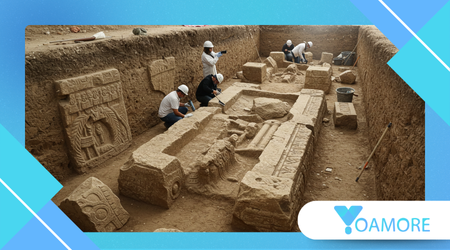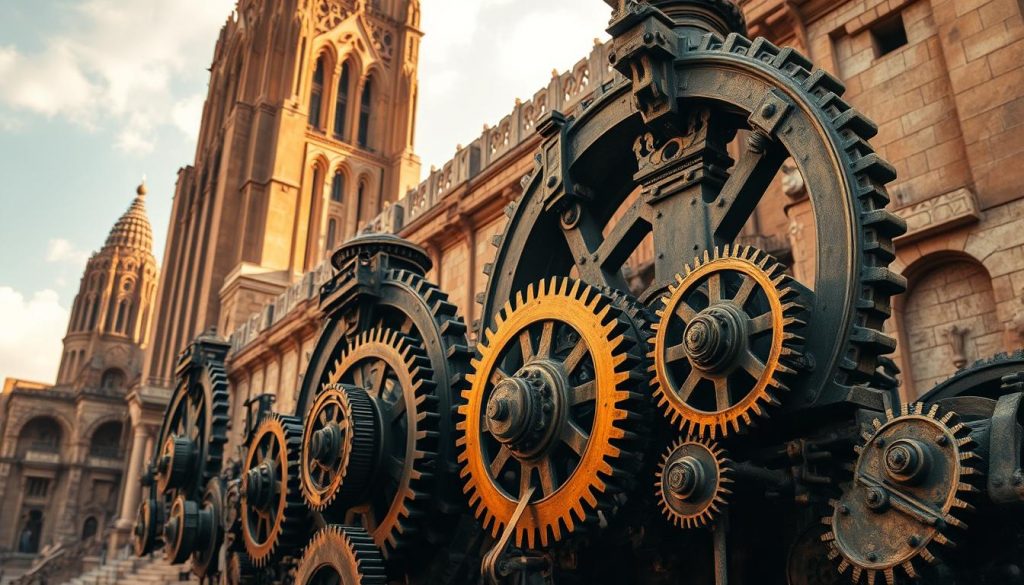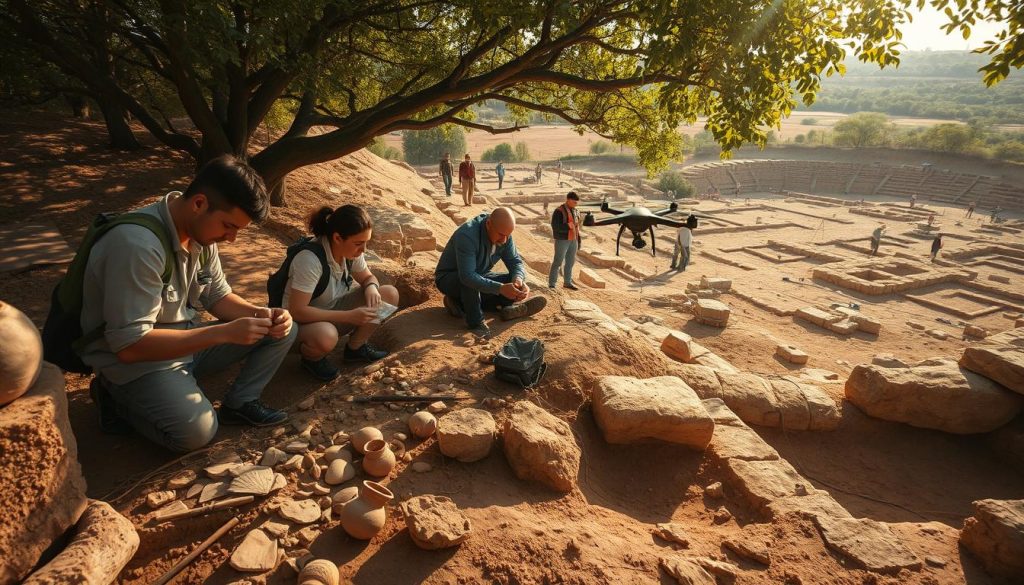5 descobertas antigas que reescreveram a história

A história não é imutável. Descobertas antigas e avanços arqueológicos continuam mudando a maneira como vemos o passado.
Anúncios
Este artigo fala sobre cinco artefatos que mudaram a história, mostrando que cada descoberta pode reescrever nossa compreensão da civilização.
Essas descobertas históricas são mais do que apenas coisas antigas. Elas são revolucionárias. Pedra de Roseta e o Exército de Terracota são exemplos de como eles nos conectam a tempos esquecidos.
Cada descoberta levanta novas questões, gerando debates e alterando linhas do tempo. Vamos mergulhar em como esses artefatos revolucionaram os livros de história.
A Busca pela História Oculta: Como Descobertas Antigas Mudam Nossa Compreensão
Desvendar o passado é uma mistura do antigo e do novo. Arqueólogos usam métodos clássicos e modernos. Essa mistura muda a forma como vemos a história.
Anúncios
A ciência por trás das revelações históricas
Ferramentas como datação por carbono e a análise de DNA nos diz quando os artefatos foram feitos.
Padrões de anéis de árvores ajudam cientistas a rastrear o tempo. Esses métodos transformam objetos antigos em janelas para o passado.
Quando as evidências desafiam as narrativas estabelecidas
A história está sempre evoluindo. Em 1960, um sítio arqueológico viking em Terra Nova mostrou que exploradores nórdicos já estavam na América do Norte antes de Colombo.
Esta descoberta levou a uma revisão histórica de quando os europeus exploraram as Américas pela primeira vez.
Tecnologia moderna desvendando segredos antigos
A tecnologia de hoje revela o que estava escondido. Radar de penetração no solo encontra estruturas subterrâneas, e o LIDAR revela cidades perdidas como Angkor Wat. Imagens de satélite identificam ruínas do espaço. Essas ferramentas revelam novos mundos.
| Tecnologia | Usar | Exemplo |
|---|---|---|
| Radar de Penetração no Solo | Escaneia camadas subterrâneas | Estradas romanas descobertas na Grã-Bretanha |
| LIDAR | Mapas de paisagens escondidas | Canais maias expostos na Guatemala |
| Imagens de satélite | Rastreia mudanças na superfície | Encontradas antigas rotas comerciais na Síria |
A Pedra de Roseta: Desvendando a Linguagem do Antigo Egito
Em 1799, soldados franceses perto do Delta do Nilo encontraram uma placa preta que mudou a história.
O Pedra de Roseta—feito em 196 a.C.—tinha a mesma mensagem em três escritas: hieróglifos, demótico (escrita egípcia) e grego antigo.
Este decreto trilíngue, dos governantes ptolomaicos, foi a chave para a compreensão da língua egípcia perdido há séculos.
Durante séculos, hieróglifos eram um mistério. Mas o estudioso francês Jean-François Champollion encontrou uma maneira de vincular os nomes gregos na pedra aos seus hieroglífico formulários.
Em 1822, ele demonstrou que esses símbolos eram mais do que apenas arte religiosa. Eram uma mistura de imagens e sons.
Essa descoberta revelou histórias de faraós, deuses e da vida cotidiana desde os tempos antigos. Hoje, Pedra de Roseta conecta os mundos antigo e moderno.
A sua decifração revelou milhares de textos, mostrando Egito AntigoAs leis, os mitos e como governavam. Sem isso, suas vozes ainda estariam em silêncio.
A obra de Champollion nos ensina: às vezes, os maiores segredos da história estão bem na nossa frente. Eles só precisam da mente certa para desvendá-los.
Göbekli Tepe: Redefinindo a Linha do Tempo da Civilização Humana
No sudeste da Turquia, Göbekli Tepe muda nossa visão da história humana. Encontrado em 1994 por Klaus Schmidt, tem 11.500 anos. É um complexo de monumentos antigos que desafia nossa compreensão do passado.
O primeiro complexo de templos do mundo
Imagine pilares em forma de T com cobras, raposas e humanos. Essas estruturas enormes, com cerca de 20 toneladas, estão dispostas em espaços circulares. Elas representam áreas rituais anteriores à escrita ou às ferramentas de metal.
Eles são 6.000 anos mais velhos que Stonehenge. Isso faz com que Göbekli Tepe o mais antigo sítio de templo conhecido.
Desafiando a Teoria da Revolução Agrícola
A história já disse que a agricultura levou às cidades e à religião. Mas Göbekli Tepe foi construído por sociedades de caçadores-coletores antes da agricultura. Isso transforma o Revolução neolítica história de cabeça para baixo.
Como grupos nômades construíram tal sítio? Sua engenhosidade nos revela um novo lado dos primeiros humanos.
O que os pilares de pedra nos dizem sobre a sociedade pré-histórica
- Pensamento simbólico: As esculturas sugerem crenças complexas.
- Cooperação: A construção desses megálitos exigiu trabalho em equipe e liderança.
- Arte: Os desenhos detalhados dos animais demonstram habilidades artísticas avançadas.
Esses sinais mostram civilização pré-histórica era mais avançado do que pensávamos. Göbekli Tepe é mais do que uma relíquia. É um vislumbre de uma época em que a espiritualidade levou à arquitetura grandiosa, antes do surgimento da agricultura.
Descobertas antigas que quebraram paradigmas arqueológicos
Algumas descobertas mudaram a nossa visão da história. Elas demonstram engenharia avançada e símbolos misteriosos. inovações pré-históricas e as conexões globais mostram o quanto ainda não sabemos.

Sofisticação tecnológica inesperada
O Mecanismo de Anticítera é um dispositivo grego de 2.000 anos. Ele rastreia eventos celestes, desafiando nossas visões de tecnologia antiga. O concreto romano, ainda forte depois de milênios, guarda segredos que estamos estudando.
Como os trabalhadores alinharam as pedras da Grande Pirâmide com tanta precisão? Estes exemplos mostram que os primeiros humanos conseguiram o que os especialistas antes consideravam impossível.
- Mecanismo de Anticítera: Um computador analógico antes do seu tempo
- Concreto romano: mais durável que os materiais modernos
- Engenharia da Grande Pirâmide: Precisão além da sua época
Evidências de conexões globais iniciais
A seda chinesa no Egito romano e as ligações de DNA entre populações distantes reescrevem a história. Essas descobertas revelam conexões antigas muito antes da Rota da Seda. Rotas comerciais e tecnologias compartilhadas revelam um mundo mais conectado do que pensávamos.
Mistérios que continuam a confundir os especialistas
“O propósito das Linhas de Nazca continua sendo um enigma envolto em mistério.”
Apesar das teorias, mistérios arqueológicos como as muralhas de Sacsayhuamán, no Peru, e sítios astronômicos globais permanecem sem solução. Como essas estruturas foram construídas?
Por que eles estavam alinhados com as estrelas? Essas questões levam a mudanças de paradigma histórico em nossa compreensão da inteligência antiga.
O Exército de Terracota: A Legião Subterrânea de Importância Histórica da China
Em 1974, agricultores que cavavam perto de Xi'an encontraram a Guerreiros de Terracota. Este exército de 2.000 anos foi enterrado para proteger Imperador Qin Shi Huang na vida após a morte. Descobriram 8.000 soldados, cavalos e carruagens prontos para a batalha.
Cada guerreiro tinha seu próprio rosto e armadura, mostrando a práticas funerárias da dinastia Qin. Essa mistura de arte e praticidade é fascinante.
Moderno Arqueologia chinesa mostrou como os artesãos antigos trabalhavam. Eles utilizavam um método de produção modular, muito antes da era industrial. Esse método ajudava a montar guerreiros a partir de peças padronizadas.
Esta inovação mudou a forma como vemos as conquistas da era Qin. O artesanato do exército, desde armas de bronze até a moldagem em argila, demonstra China antigahabilidade de 's. Eles combinavam crenças espirituais com engenharia avançada.
Hoje, o local desafia antigas visões do reinado de Qin. Guerreiros de Terracota eram mais do que guardas de tumbas. Eles representam o desejo do Imperador Qin Shi Huang por poder eterno. Sua descoberta remodelou nossa compreensão de China antigaproeza técnica.
Machu Picchu: A Cidade Perdida que Revelou a Gênio da Engenharia Inca
Em 1911, Hiram Bingham encontrado Machu Picchu, uma cidade que parecia congelada no tempo. Está localizada nos Andes e é uma obra-prima da Civilização Inca.
Mostrou que o povo inca era muito mais avançado do que se pensava, com incríveis engenharia antiga e Arquitetura andina.
Alinhamentos astronômicos e funções de calendário
Cada pedra em Machu Picchu conta a história das estrelas. A pedra Intihuatana marca o solstício de junho, sem sombra ao meio-dia. O Templo do Sol se alinha com o solstício de inverno, com suas paredes seguindo a trajetória do sol.
Essas estruturas eram calendários que guiavam eventos agrícolas e religiosos. Elas demonstram uma precisão incrível, rivalizando com os observatórios atuais.
Técnicas de construção que desafiaram a compreensão colonial
Os registros coloniais dizem que os construtores indígenas eram simples. Mas Machu Picchu mostraram que estavam errados. A cidade engenharia antiga incluído:
- Pedras interligadas sem argamassa, tornando as paredes fortes contra terremotos.
- Canais de drenagem que mantinham a água longe dos terraços, impedindo a erosão.
- Fundações construídas nas montanhas, misturando-se aos Andes.
Essas inovações provaram a habilidade dos Incas em Arquitetura andina. Eles mudaram a forma como vemos as sociedades pré-colombianas. Machu Picchu é o símbolo de uma civilização verdadeiramente à frente de seu tempo.
Os Manuscritos do Mar Morto: Textos Antigos que Transformaram a História Religiosa
Em 1947, uma descoberta casual perto do Mar Morto revelou fragmentos da história. Esses fragmentos remodelaram nossa compreensão da judaísmo antigo e primeiros textos religiosos.
O Manuscritos do Mar Morto, encontrado no Cavernas de Qumran, representam mais de 2.000 anos de conhecimento preservado. Sua história começou com uma cabra e um pastor adolescente.
A descoberta acidental em Qumran
O pastor Jum'a Muhammad Ahmad encontrou um jarro de barro em uma caverna na encosta de um penhasco enquanto procurava por gado perdido. Dentro dele, havia pergaminhos que mais tarde foram associados a uma comunidade perto de Qumran.
Mais de 900 manuscritos emergiram de 11 cavernas, incluindo fragmentos de todos os livros da Bíblia Hebraica, exceto Ester.
O Cavernas de Qumran tornou-se um ponto focal para arqueologia textual, revelando como os antigos escribas preservavam textos sagrados.
Como esses manuscritos mudaram os estudos bíblicos
Antes dessas descobertas, o mais antigo conhecido manuscritos bíblicos datado do século X d.C. Os pergaminhos, abrangendo de 250 a.C. a 68 d.C., mostraram notável consistência com textos posteriores — mas também revelaram variações na grafia e na fraseologia. Os principais insights incluem:
- Pistas sobre a diversidade do judaísmo do Segundo Templo
- Cópias mais antigas de salmos e profecias
- Evidências da coexistência de múltiplas seitas judaicas
Esses manuscritos bíblicos também esclarecem como as primeiras ideias cristãs surgiram desse cenário religioso.
Controvérsias e Pesquisas Contínuas
Durante décadas, o acesso aos pergaminhos foi rigorosamente controlado, atrasando a análise global. Ainda hoje se debatem intensamente sobre suas origens — quem os escreveu?
Escritos essênios ou coletados em bibliotecas? A tecnologia de imagem moderna agora permite que estudiosos estudem pergaminhos frágeis sem desenrolá-los, avançando arqueologia textual.
À medida que a pesquisa prossegue, a Manuscritos do Mar Morto nos lembra que os segredos da história muitas vezes se escondem em lugares inesperados.
Como essas descobertas continuam a moldar a pesquisa e a compreensão modernas
O impacto de descobertas como a Pedra de Roseta e formas de Göbekli Tepe métodos históricos hoje. Pesquisadores usam tomografias computadorizadas e IA para estudar fragmentos dos Manuscritos do Mar Morto.
Isto revela novos insights sobre os textos bíblicos. Em Göbekli Tepe, escavações em andamento lançam luz sobre a cooperação humana primitiva. Mostram que sociedades complexas existiam antes do que se pensava.

- Reescrevendo a História: Novas traduções de scripts não decifrados baseiam-se nas técnicas da Pedra de Roseta.
- Patrimônio Cultural: Os museus agora priorizam colaborações globais para repatriar artefatos como os Bronzes de Benin.
- Tecnologia moderna: Drones mapeiam os terraços de Machu Picchu, comprovando a visão da engenharia inca.
| Descoberta | Impacto Moderno |
|---|---|
| Pedra de Roseta | Informa projetos de restauração de linguagem baseados em IA |
| Göbekli Tepe | Mudanças nas teorias sobre as estruturas sociais neolíticas |
| Manuscritos do Mar Morto | A digitalização auxilia o diálogo inter-religioso por meio de bolsas de estudo acessíveis |
As universidades agora ensinam essas descobertas como estudos de caso para práticas éticas de escavação. O programa de Patrimônios Mundiais da UNESCO usa esses exemplos para proteger sítios ameaçados, como os zigurates da Mesopotâmia.
“Cada fragmento conta uma história”, diz a Dra. Elena Marquez, do Museu Britânico, “esses sítios nos lembram que a história é um diálogo vivo”.
Conclusão: A busca incessante para descobrir nossa história humana compartilhada
Descoberta histórica continua mudando a forma como vemos o passado. A Pedra de Roseta e Machu Picchu nos mostram o que é possível. Agora, ferramentas como imagens de satélite e IA nos ajudam a encontrar sítios escondidos, mudando a forma como vemos a história humana.
Proteger a história precisa da ajuda de todos. Lugares como os Manuscritos do Mar Morto e as pirâmides egípcias estão em risco devido às mudanças climáticas e ao crescimento das cidades. Salvar esses sítios nos ajuda a continuar aprendendo com a história.
Nosso patrimônio cultural É para todos. Novas tecnologias, como drones e LiDAR, nos permitem ver como os povos antigos se conectavam. Essas descobertas mostram que a história é cheia de surpresas. Que segredos desvendaremos a seguir?
